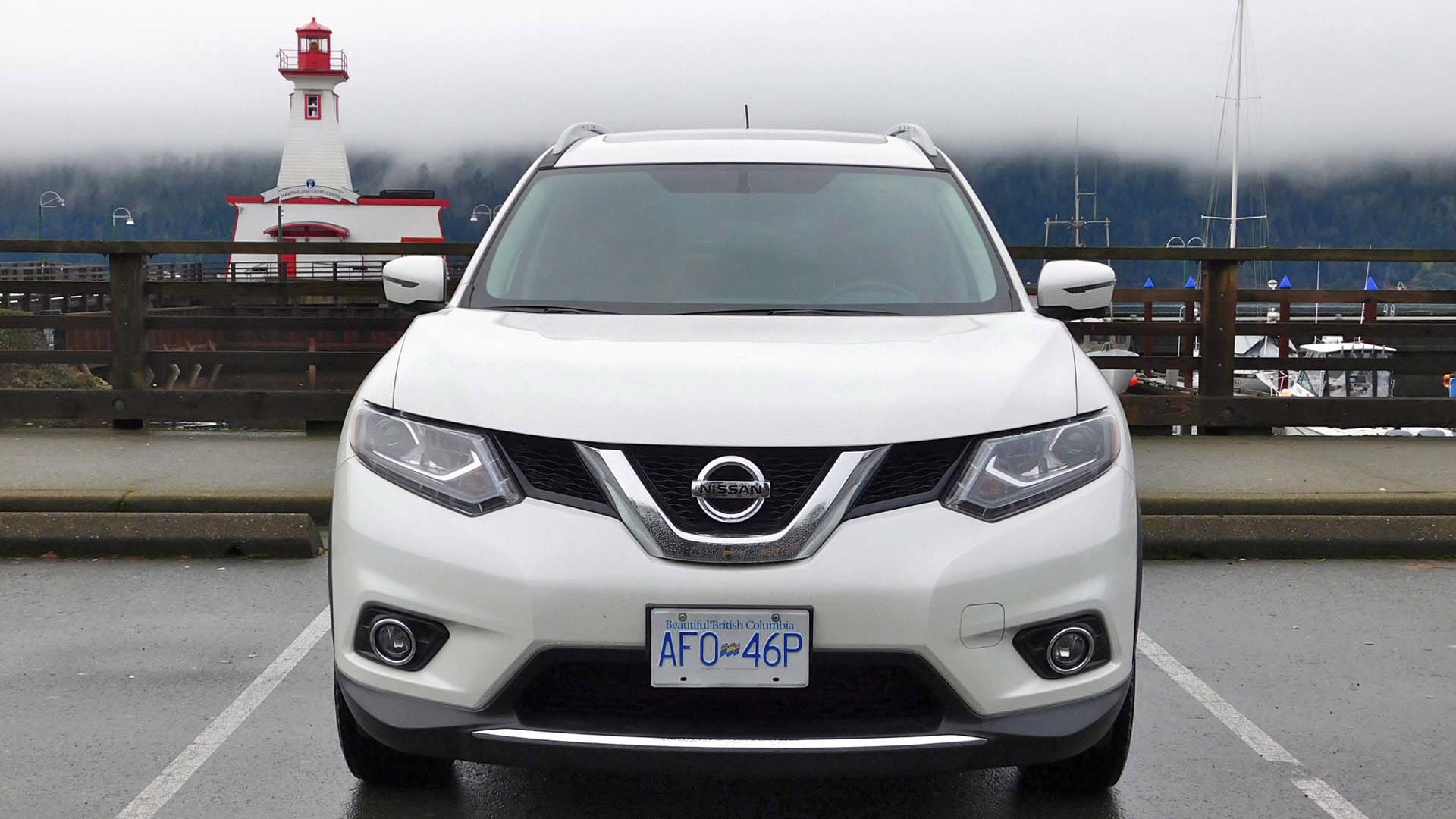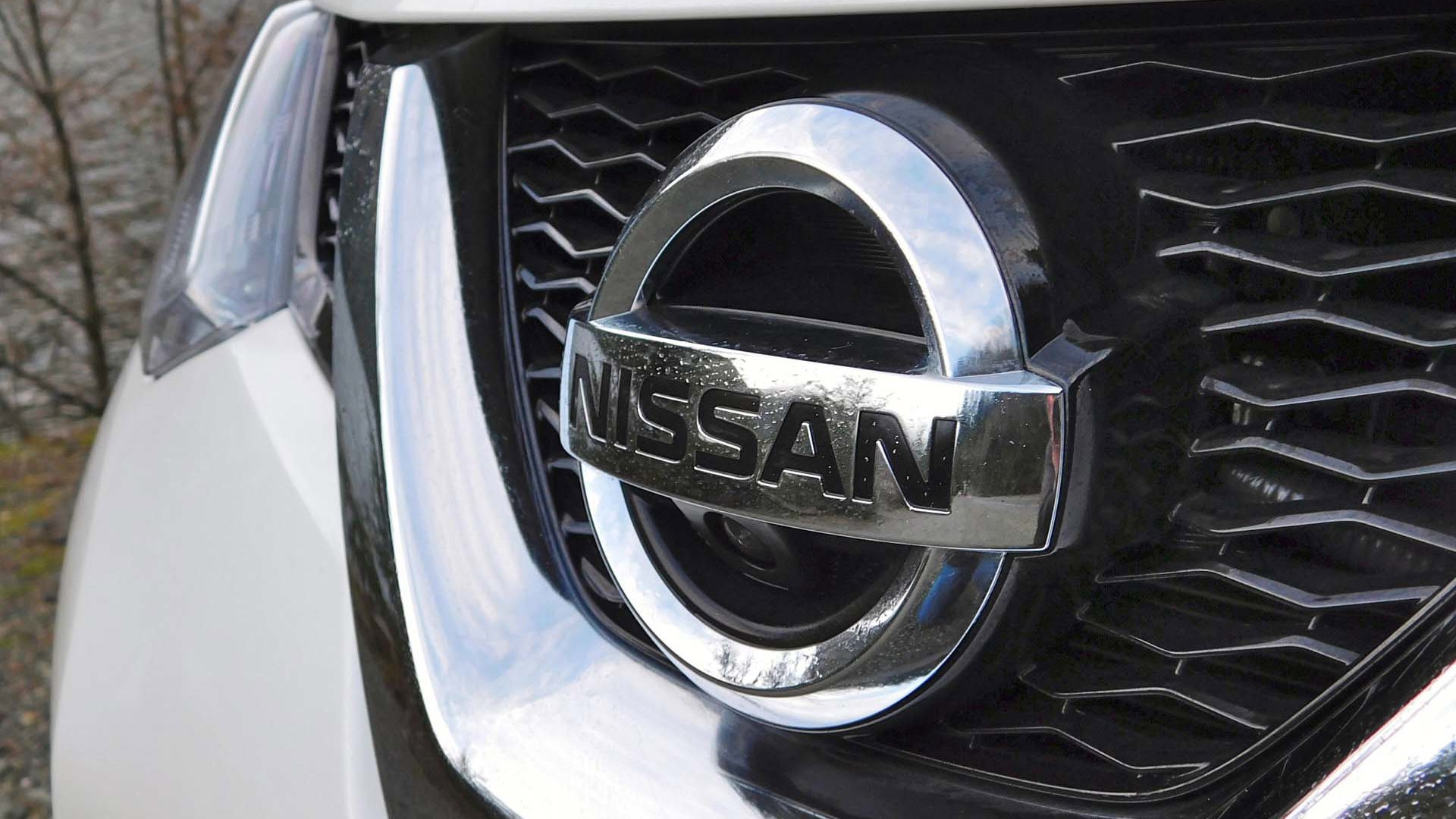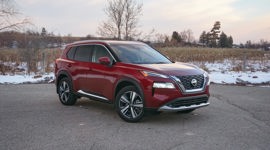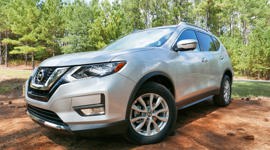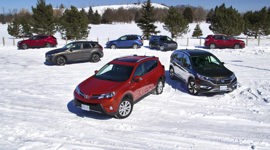 AutoTrader SCORE
AutoTrader SCORE
-
INTERIOR9/10
-
EXTERIOR STYLING8/10
-
FUEL ECONOMY8/10
-
PERFORMANCE6/10
-
COMFORT8/10
Over the past decade compact CUVs have become the family car of choice for many Canadians, so while the fourth-best selling Nissan Rogue (based on total 2015 sales) might fall just shy of being a household name, its top-three selling rivals certainly are: think Ford Escape, Toyota RAV4, and Honda CR-V. It's some pretty stiff competition to be chasing, but Nissan's stylish contender stacks up nicely.
To my eye it's the best-looking of the top-four compact CUVs by a solid margin.
The current, second-generation Rogue was introduced for 2014, and two years later it remains fresh and modern looking. To my eye it's the best-looking of the top-four compact CUVs by a solid margin. In terms of utility it perhaps gives up a little compared to the CR-V (mostly because the CR-V has such crafty rear seat folding mechanisms), but it holds its own against the Escape and RAV4, and it boasts the largest overall cargo capacity with the rear seats in place (1,112 L, which is 22 L better than the next-biggest RAV4 and a full 41 L bigger than the Escape). Fold the seats and you get 1,982 L.
Where the Rogue really distinguishes itself is with an interior that somehow transcends its mass-market roots to create a serene, luxurious environment that echoes Nissan's Infiniti luxury brand. The Rogue also trumps the top three by offering optional third-row seating, and it can be had with a wide array of safety technologies that combine with good crash test results across the board to earn an IIHS Top Safety Pick+ award. I was given a range-topping SL Premium Rogue for my week-long test drive, but you don't need to splurge on a top-of-the-line model to get an impressive array of equipment.
The cabin features a soft-surface dash, soft-touch door uppers and soft-touch console top, with good-looking rigid plastics elsewhere. Visual interest is provided by a mix of faux-carbon fibre and painted metallic trim, with a splash of shiny piano black on the centre stack (great if you like it, but difficult to keep clean). There's nothing earth-shatteringly uncommon about any of the materials but they're deployed to good effect, with a slightly more generous than average use of soft-surface materials and a pleasing, ergonomically-efficient dashboard layout. There's a nice big console bin for your essentials, with air conditioning, ambient lighting, three 12V outlets, cruise control, keyless entry, rearview monitor, Bluetooth connectivity, hands-free text messaging and NissanConnect mobile apps integration all standard across the lineup.
Family feud: Comparison Test: 2015 Honda CR-V vs Nissan Rogue
My SL Premium test car added features including dual-zone automatic climate control, a panoramic sunroof, 18-inch alloys (lower trims get 17-inch steel or alloy wheels), blind-spot information system, forward collision warning, lane departure warning, intelligent key with pushbutton start, auto-dimming rearview mirror, power liftgate, navigation system with 7-inch touchscreen and a powerful, clear-sounding nine-speaker Bose audio system (lower trims get a 5-inch screen with either a four- or six speaker audio system). I found the nav screen a little on the small side (with touch points a little on the small-side too), but the interface is reasonably intuitive and the nav system makes the best of the available screen by automatically zooming in and out as the vehicle slows down and speeds up.
The front seats use Nissan's NASA-inspired "zero gravity" design principles and proved roomy and comfortable around town, although I found they fell short of the exceptional long-distance comfort afforded by the zero-gravity seats in Nissan's Altima and Maxima sedans: Perhaps it's due to the more upright CUV seating position, or a shorter or more rounded seat squab, but after a couple hours behind the wheel I found that the squab pressed somewhat uncomfortably into my mid-thigh. Standard upholstery is cloth, and my SL Premium test car upped the luxury factor with perforated leather upholstery to match its leather-wrapped steering wheel and shift knob. Outward visibility is a bit restricted thanks to the rather thick A-pillars and small back windows, but the standard rearview monitor (and the impressive bird's-eye around-view monitor in my SL premium test car) make parking a cinch regardless.
The back seat offers excellent leg room and headroom, and the 60/40 split folding seatbacks recline for additional comfort and feature a pass-through armrest. My test car wasn't fitted with the optional third-row seating (that's available only in the SV trim), but the limited headroom further back means those two additional seats would best be suited for small children or occasional use. Still, it's a handy option for a family that doesn't really require a big seven seater but sometimes has need to squeeze in a couple of extra passengers.
The cargo area itself is big and easy to access, and provided you skip the third-row seating it features a couple of useful underfloor bins to keep things hidden (or to stop larger cargo from sliding around), with slots to allow you to configure the floor in different ways for carrying mixed cargo (it's always nice being able to prevent your exercise weights from playing roller derby with the eggs on the way home). One minor annoyance is that the rigid aft edge of the cargo cover tends to droop down and interfere somewhat when loading stuff in the back. You can flip it upright to get it out of the way, but then there's a tendency to forget it and drive off, only to discover that you now can't see out the rearview mirror. I also noticed that if you unlock and open just the rear power liftgate, you couldn't then unlock the passenger doors while the liftgate was still open (not without popping the actual mechanical key out of the fob and using it to open the driver's door).
On the road the Rogue puts the emphasis on comfort, efficiency, and ease of driving. Power for all models is from a 2.5L 16-valve 4-cylinder engine rated for 170 hp and 175 lb-ft of torque, fed through a CVT automatic transmission. Nissan's Intuitive All-Wheel Drive is standard in the SL trim and optional in the S and SV trims, and while the system is an on-demand setup it's more sophisticated than most slip-and-grip systems, offering torque vectoring during acceleration and cornering for more sure-footed response.
Much ink has been spilled over Nissan's dedication to CVT transmissions, but that dedication means the company has been able to refine the design over the years. The Rogue's CVT works quietly and unobtrusively in the background, and contributes to the car's serene demeanour when cruising and accelerating gently thanks to its tall highway gearing and seamless delivery of power. I'm still no fan of the droning, disconnected character you get with a CVT when accelerating hard (it takes the Rogue about 9.8 seconds to scurry from 0-100 km/h, with a fair amount of chatter from the engine), however the Rogue's transmission programming does get points for including automatic engine braking when going down steep hills.
A bank of semi-hidden switches at the lower left of the dash provide various driving modes and traction assistance settings. You can select from normal, Eco and Sport modes, with Eco mode dulling throttle response and holding revs to about 2,500 rpm during moderate acceleration (compared to about 3,000 rpm in normal mode) while Sport mode sharpens throttle response and holds revs closer to 4,000 rpm during moderate acceleration. There's also a hill descent control for steeper soft-road descents, and AWD lock for low-speed crawling out of slippery situations.
In terms of ride and handling the Rogue does exactly what its target customers want: it provides a comfortable, almost soft ride while still delivering easy and composed handling. You could accuse the steering of being a bit numb and the handling a bit squishy (and the suspension can hammer a little over particularly large, sharp bumps) but all that's beside the point: The Rogue goes where you point it with a minimum of fuss, glides along the highway with utmost serenity, and if you overcook it a little in a corner the front wheels will scrub off speed in a predictable, safe-feeling manner. Job done.
Pricing for the base Rogue S starts at $24,648 before freight, which is less than either of its chief Japanese rivals and within $1,000 of the base Ford Escape. The top-end SL Premium trim starts at $35,248. The Rogue shouldn't cost you an arm or a leg at the pump, either: Official city/highway ratings are 7.4/9.5 L/100 km for the AWD version, and my real-world results weren't too far off these ratings, with a highway average of about 8.5 L/100km, rising to 10.2 L/100km in mixed city and mountain driving.
With its stylish looks, above average interior, docile manners, and wide array of available convenience and safety equipment, you could hardly accuse the competitively-priced Rogue of being truly roguish. About the only way it really breaks with compact CUV tradition is by offering third-row seating, and in all other respects it's best summed up as competent and, um … likeable. A likeable Rogue indeed.
| Warranty: 3 years/60,000 km; 5 years/100,000 km powertrain; 5 years/unlimited distance corrosion perforation; 3 years/60,000 km roadside assistance Competitors: |
| Model Tested | 2016 Nissan Rogue SL Premium |
|---|---|
| Base Price | $35,248 |
| A/C Tax | $100 |
| Destination Fee | $1,760 |
| Price as Tested | $37,408 |
|
Optional Equipment
$300 (3-Coat Paint)
|
|

